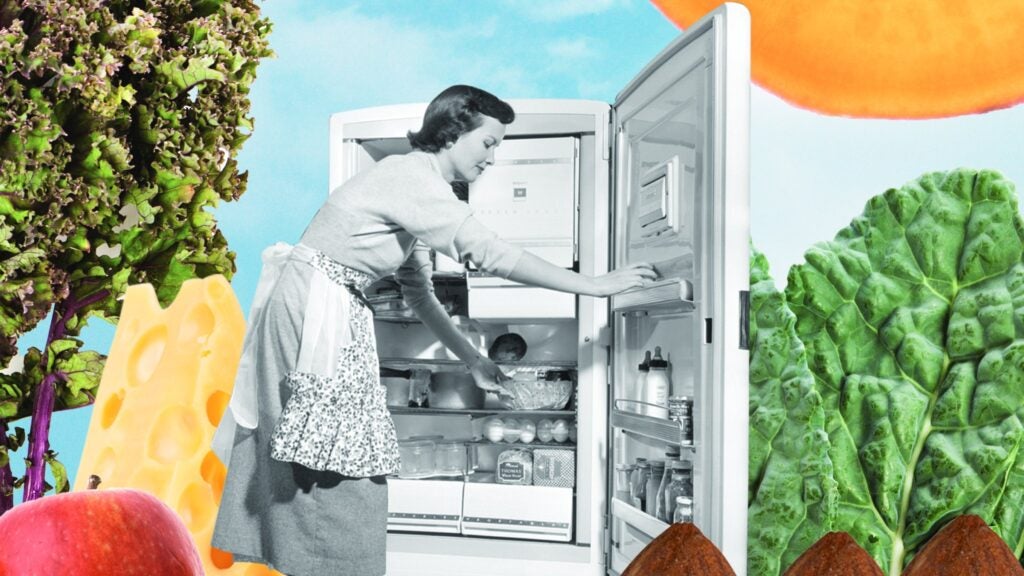“], “filter”: { “nextExceptions”: “img, blockquote, div”, “nextContainsExceptions”: “img, blockquote, a.btn, a.o-button”} }”>
New perk: Easily find new routes and hidden gems, upcoming running events, and more near you. Your weekly Local Running Newsletter has everything you need to lace up!
>”,”name”:”in-content-cta”,”type”:”link”}}”>Subscribe today.
For the average woman, menopause—which officially kicks off when your period has stopped for 12 months—occurs at age 51. As this natural, biological change continues to unfold, many masters athletes find that what’s worked for them in the past requires adjusting—what you eat in your 50s needs to change.
For instance, gels and chews that once powered you through a long run might now upset your stomach. In part, that’s because your body has a harder time metabolizing simple sugars such as fructose. In addition, menopause makes it harder to use the hormone insulin to turn blood glucose into energy, sports dietitian Lydia Nader says.
Over time, these shifts can leave you prone to bonking—and also increase your risk for health problems like type 2 diabetes and metabolic syndrome. So while carbohydrates remain the essential fuel source for activity at any age, masters athletes can benefit from being more picky about their sources, Nader says, including seeking out more complex carbohydrates.
Without your monthly blood flow, your iron needs may decrease, but your body’s ability to absorb other nutrients, including B vitamins, declines. And the ongoing decrease of estrogen and progesterone continues to decrease your bone mineral density.
RELATED: How to Train Through Low Iron
If all this sounds like a big bummer, take heart. “Lower metabolic rates, decreased lean body mass, losing muscle strength, slowing pace—yes, those things will sometimes happen,” registered dietitian nutritionist Lauren Antonucci says. “But the bridge between physiology, performance, and nutrition is really exciting. There’s a lot we can do to help prevent or delay some of those so-called inevitables.”
Tips for What to Eat Your 50s
Upgrade Your Carbs
Aim to meet at least half your carb needs with high-quality sources, selecting items low on what’s called the glycemic index, a measure of how quickly a food spikes your blood sugar. Think wild rice instead of white, quinoa instead of pasta, and loads of veggies, Nader recommends. Not only will you have energy for your workouts, you’ll also pack in more of the other nutrients you need, including fiber, key to heart and gut health.
Scale Back on Sugar
The latest dietary guidelines recommend Americans get less than 10 percent of their daily calories from added sugars, those not found naturally in foods like fruit or grains. While research suggests people of all ages tend to overdo it, menopausal women’s metabolisms may have the most to gain from cutting back. In addition, though natural sugars from fruit come packaged with other nutrients, Nader still sometimes suggests older athletes limit themselves to one or two servings per day, and eat them in the morning or soon before or after a workout.
Switch Up Your Fuel
If you’re going longer distances and find yourself running on fumes (or in gastrointestinal distress) try a more balanced source of mid-run energy, Nader suggests. Test out gels that include a bit of protein and fat, such as those made by Spring. Or experiment with balanced, solid foods like Clif or Picky Bars, homemade protein bites, or sandwich squares.
Secure Your Skeleton
Your daily calcium requirement bumps back up to 1,200 milligrams after age 50 to protect your bones. Increase your intake to four or five servings of dairy or the equivalent—and don’t skimp on vitamin D, either, which increases calcium absorption. Aging reduces the rate at which your skin produces vitamin D in the sun, and food sources are few; in many cases, your doctor or a dietitian may recommend supplements.
